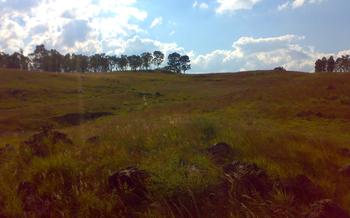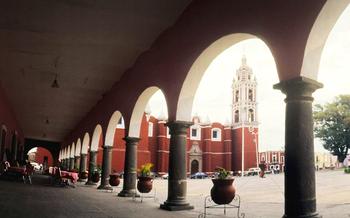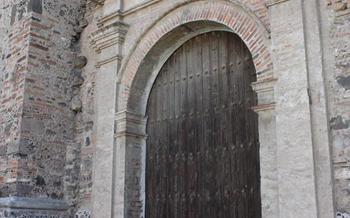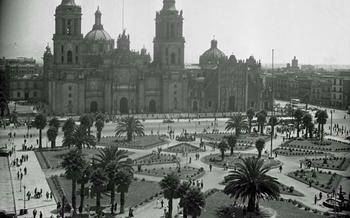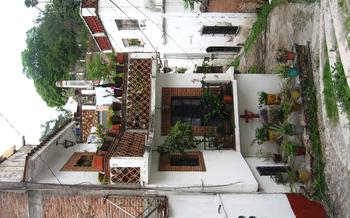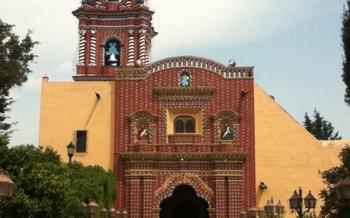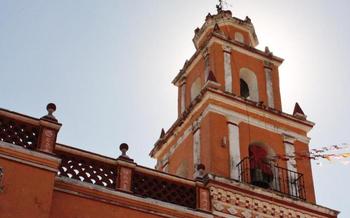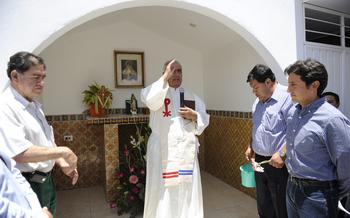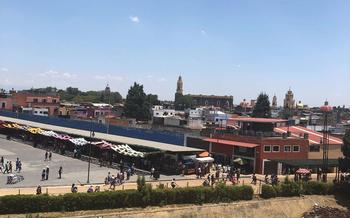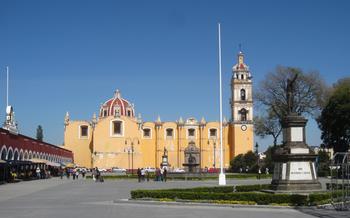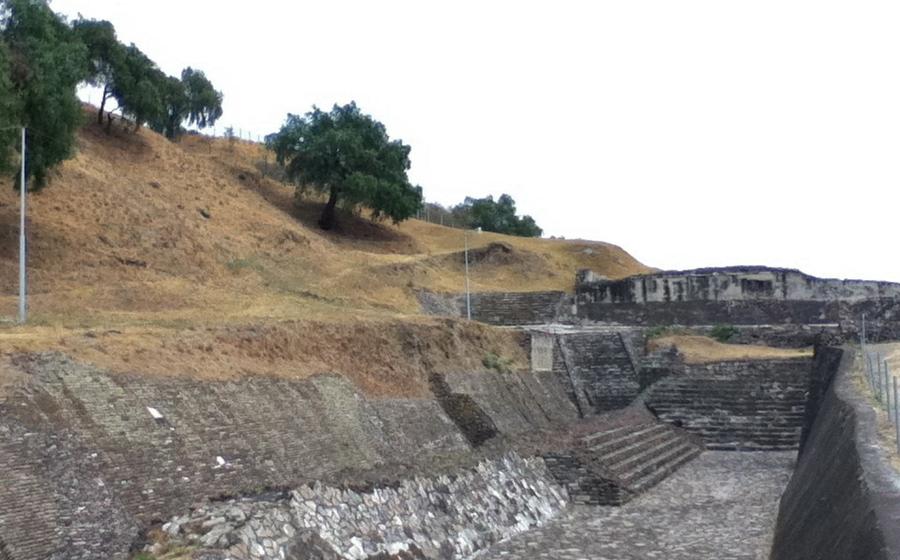
Pirámide Tepanapa
- Architectural Features
- Location and Access
- Public Transportation
- Private Vehicle
- Accessibility
- Guided Tours
- Exploration and Activities
- Cultural Significance
- Best Time to Visit
- Photography and Videography
- Local Cuisine and Dining
- Nearby Attractions: Exploring the Treasures of Puebla
- Shopping and Souvenirs
- Accommodation Options
- Safety and Precautions
- Language and Communication
- Insider Tip: Uncovering the Hidden Cenote
Architectural Features
The Pirámide Tepanapa stands as a testament to the architectural prowess of the ancient civilizations that inhabited the region. Constructed using a combination of stone and adobe bricks, the pyramid showcases a unique blend of building techniques and materials. The exterior of the pyramid is adorned with intricate carvings and bas-reliefs, depicting various deities, mythical creatures, and scenes from everyday life. The pyramid's stepped design, with each level representing a different celestial realm, adds to its architectural significance. The precise alignment of the pyramid with astronomical events, such as the solstices and equinoxes, further highlights the advanced understanding of astronomy possessed by its builders. The overall design of the Pirámide Tepanapa reflects the deep connection between the ancient civilizations and the cosmos, making it a captivating sight for visitors interested in ancient architecture and cultural heritage.
Location and Access
The Pirámide Tepanapa is strategically located in the heart of the city of Tepeaca, in the state of Puebla, Mexico. Its proximity to major cities like Puebla (approximately 45 kilometers away) and Mexico City (about 120 kilometers away) makes it easily accessible for tourists and visitors. Reaching the pyramid is relatively straightforward, whether you choose to travel by public transportation or private vehicle.
Public Transportation
If you prefer public transportation, you can take a bus from either Puebla or Mexico City to Tepeaca. Once in Tepeaca, you can easily hail a taxi or catch a local bus that will take you directly to the pyramid. The journey from Puebla typically takes around 1 hour and 30 minutes, while from Mexico City, it can take up to 3 hours, depending on traffic conditions.
Private Vehicle
For those who prefer the convenience of their own vehicle, driving to the pyramid is a scenic and enjoyable experience. From Puebla, take Highway 150 towards Tepeaca. Once you reach Tepeaca, follow the signs to the pyramid, which is located just a few kilometers outside the city center. Parking is readily available near the pyramid, making it easy for visitors to park their vehicles safely.
Accessibility
The Pirámide Tepanapa is generally accessible for visitors of all abilities. Paved pathways lead from the parking area to the base of the pyramid, making it easy for wheelchairs and strollers to navigate. However, it's important to note that climbing the pyramid's steep steps requires a certain level of physical fitness and may not be suitable for everyone.
Guided Tours
For a more immersive experience, consider joining a guided tour of the pyramid. Several tour operators in the area offer guided tours that provide in-depth historical and cultural insights into the pyramid and its significance. These tours typically include transportation from Puebla or Mexico City, a guided ascent of the pyramid, and visits to other nearby attractions.
Exploration and Activities
The journey to the Pirámide Tepanapa offers a unique blend of adventure and exploration. Navigating through the lush greenery, visitors will encounter a network of well-maintained hiking trails and paths that lead directly to the base of the pyramid. These trails offer varying levels of difficulty, catering to both experienced hikers and those seeking a leisurely stroll.
Safety is paramount when exploring the pyramid. Visitors are advised to wear sturdy footwear and comfortable clothing suitable for outdoor activities. The pyramid's surface can be uneven and slippery, so it's essential to proceed with caution and avoid climbing on unstable sections. Guided tours are available for those who prefer a more structured and informative experience.
Once at the pyramid, visitors can engage in various activities to enhance their visit. Photography enthusiasts will delight in capturing the pyramid's grandeur, intricate details, and the surrounding natural beauty. Nature lovers can embark on a tranquil walk through the nearby forest, observing the diverse flora and fauna that call this region home. For a deeper understanding of the pyramid's history and significance, guided tours led by knowledgeable experts provide insights into the ancient civilization that constructed this remarkable monument.
Conveniently located near the pyramid, visitors will find basic facilities such as restrooms and a visitor center. The visitor center serves as a valuable resource, offering informative exhibits, maps, and brochures that further enrich the exploration experience. Souvenirs and local crafts are also available for purchase, providing visitors with a tangible reminder of their time at the Pirámide Tepanapa.
Cultural Significance
The Pirámide Tepanapa holds immense cultural significance for the local community of Puebla. It serves as a powerful symbol of their rich heritage and cultural identity, deeply intertwined with the indigenous traditions of the region. The pyramid is integrated into local festivals, celebrations, and ceremonies, where it becomes a focal point for community gatherings and cultural expressions.
Legends and myths associated with the pyramid have been passed down through generations, adding to its mystique and cultural importance. These stories often involve ancient deities, heroic figures, and tales of creation and transformation. The pyramid's enduring presence has inspired local artisans and craftsmen to create intricate pottery, textiles, and other handicrafts that reflect its cultural significance.
Moreover, the Pirámide Tepanapa plays a crucial role in promoting cultural heritage and identity in Puebla. It serves as a reminder of the region's pre-Columbian roots and the resilience of its indigenous communities. The pyramid's preservation and promotion have contributed to a sense of pride and cultural awareness among the local population, fostering a deep appreciation for their ancestral legacy.
Best Time to Visit
When planning a trip to the Pirámide Tepanapa, timing is crucial for an optimal experience. The ideal time to visit is during the dry season, which typically runs from November to April. During these months, the weather is generally pleasant, with warm days and cool nights, making it perfect for outdoor exploration. The skies are often clear, providing excellent opportunities for photography and capturing stunning views of the pyramid against the backdrop of the surrounding landscape.
Although the pyramid is accessible year-round, it's worth noting that the rainy season, from May to October, can bring unpredictable weather, including heavy downpours and humidity. While the lush greenery during this time can be picturesque, the slippery trails and potential flooding can make navigating the site more challenging. Additionally, some activities, such as guided tours, may be limited or canceled due to weather conditions.
If you're flexible with your travel dates, consider visiting during the spring (March-April) or fall (September-October) for a balance of pleasant weather and fewer crowds. These shoulder seasons offer a more intimate and tranquil experience, allowing you to fully immerse yourself in the pyramid's history and grandeur without the hustle and bustle of peak tourist season.
To make the most of your visit, plan your arrival early in the morning or late afternoon to avoid the midday heat and capture the best lighting conditions for photography. The golden hues of sunrise and sunset cast a magical glow on the pyramid, creating a breathtaking spectacle that's not to be missed.
Photography and Videography
When it comes to capturing the grandeur of Pirámide Tepanapa, photography and videography enthusiasts have a field day. The pyramid's imposing structure against the backdrop of the lush greenery creates a visually captivating scene. To make the most of your photography experience, bring a wide-angle lens to capture the pyramid's full scale and a telephoto lens for close-up shots of the intricate carvings and iconography. Tripods are highly recommended for steady shots, especially during low-light conditions.
For budding filmmakers, the pyramid offers a unique opportunity to create captivating videos. Use drone footage to showcase the pyramid's location amidst the surrounding landscape, and capture the changing light and shadows throughout the day to add depth and drama to your shots. Remember to be respectful of other visitors and avoid using flash photography or drones that might disturb the tranquil atmosphere of the site.
Local Cuisine and Dining
When exploring the Pirámide Tepanapa, immerse yourself in the vibrant culinary traditions of Puebla. Indulge in the local specialty, Cemitas Poblanas, a savory sandwich filled with succulent pork, avocado, and a variety of flavorful toppings. For a taste of traditional Mexican cuisine, try Chiles en Nogada, a dish of poblano peppers stuffed with picadillo and topped with a creamy walnut sauce.
For an authentic dining experience, visit the Mercado de Sabores Poblanos, a bustling market showcasing the region's gastronomic delights. Sample fresh Tostadas, Sopes, and Chalupas, topped with an array of local ingredients. Don't miss the chance to try Mole Poblano, a complex and flavorful sauce made with over 20 ingredients, often served with chicken or turkey.
When seeking a sweet treat, savor Camotes Poblanos, candied sweet potatoes, or Tortitas de Santa Clara, delicate pastries filled with sweet potato and pumpkin. Wash down your meal with a refreshing glass of Agua de Jamaica, a hibiscus flower drink, or Pulque, a traditional fermented beverage made from agave sap.
By embracing the local cuisine, you'll not only satisfy your taste buds but also gain a deeper appreciation for the rich cultural heritage of Puebla.
Nearby Attractions: Exploring the Treasures of Puebla
Beyond the captivating allure of the Pirámide Tepanapa, the region of Puebla boasts a treasure trove of additional attractions that beckon adventure-seekers and culture enthusiasts. The city of Puebla, a UNESCO World Heritage Site, captivates with its colonial architecture, vibrant markets, and culinary delights. Visitors can stroll through the historic center, admiring the ornate facades of churches and mansions, or indulge in the flavors of traditional Poblano cuisine at one of the many local restaurants.
Just a short drive from the pyramid, the Africam Safari park offers a unique wildlife experience, allowing visitors to observe exotic animals roaming freely in their natural habitat. The park is home to over 2,500 animals from all corners of the globe, including lions, giraffes, elephants, and zebras. Visitors can embark on a safari tour or opt for a more adventurous encounter, such as feeding the giraffes or interacting with the friendly lemurs.
For those seeking spiritual enlightenment, the Santuario de Nuestra Señora de los Remedios, perched atop a hill overlooking the city of Cholula, is a must-visit. This impressive sanctuary, adorned with intricate murals and elaborate altars, is a testament to the deep-rooted Catholic faith of the region. Visitors can climb the 465 steps leading to the sanctuary, enjoying panoramic views of the surrounding countryside as they ascend.
History buffs will be fascinated by the Museo Regional de Cholula, which houses a collection of artifacts and exhibits showcasing the rich cultural heritage of the region. Visitors can learn about the ancient civilizations that inhabited the area, admire pre-Columbian pottery and sculptures, and gain insights into the region's colonial past. The museum is a valuable resource for anyone interested in delving deeper into the history of Puebla.
These are just a few of the many attractions that await visitors in the vicinity of the Pirámide Tepanapa. Whether you're drawn to history, nature, or cultural experiences, the region offers a wealth of opportunities to explore, learn, and create lasting memories.
Shopping and Souvenirs
Strolling through the vibrant markets or artisanal shops near the Pirámide Tepanapa, visitors have the opportunity to immerse themselves in the local culture and take home a piece of the region's heritage. From intricately woven textiles and pottery to hand-carved wooden sculptures and silver jewelry, there is a treasure trove of unique souvenirs waiting to be discovered.
Souvenirs from Tepanapa hold significant value as cultural artifacts, embodying the artistic traditions and craftsmanship of the local community. By purchasing these items, visitors not only acquire a tangible memento of their visit but also support the livelihood of local artisans and craftsmen.
To ensure an authentic shopping experience, it is recommended to visit traditional markets or cooperatives where artisans directly sell their creations. These markets offer a vibrant atmosphere, allowing visitors to interact with the makers and learn about the stories behind each handcrafted piece.
When packing and transporting souvenirs, it is essential to take precautions to protect fragile items from damage. Wrapping them securely in soft materials and using sturdy containers can help prevent breakage during travel. It is also advisable to declare any valuable or antique items to customs officials to avoid any complications.
Accommodation Options
When planning your trip to the Pirámide Tepanapa, you will have a range of accommodation options to choose from. Whether you're a budget traveler or seeking a luxurious experience, there are options to suit every preference and budget.
For budget-conscious travelers, hostels and guesthouses offer affordable shared or private rooms. These accommodations provide a social atmosphere and a chance to interact with fellow travelers. Hostels like "La Casa del Abuelo" or "Hostel Casa Frida" are popular choices, offering basic amenities and a friendly ambiance.
If you prefer more privacy and comfort, numerous hotels are located near the pyramid. These hotels range from mid-range options like "Hotel Boutique Casa del Virrey" to luxury resorts like "Hotel Quinta Real Puebla." These hotels offer amenities such as swimming pools, fitness centers, and restaurants, ensuring a comfortable and convenient stay.
For a truly unique experience, consider staying in a traditional Mexican hacienda. These historic properties, like "Hacienda San Miguel" or "Hacienda del Carmen," offer a glimpse into Mexico's rich cultural heritage. They often feature beautiful gardens, colonial-style architecture, and authentic Mexican cuisine.
No matter your budget or preferences, you're sure to find an accommodation option that meets your needs and enhances your overall experience at the Pirámide Tepanapa.
Safety and Precautions
When exploring the Pirámide Tepanapa and its surroundings, it's essential to prioritize safety. Here are some tips to ensure a safe and enjoyable visit:
-
Be aware of your surroundings: Remain vigilant and pay attention to your belongings, especially in crowded areas.
-
Follow designated paths: Stick to designated trails and avoid venturing off into unmarked areas to prevent getting lost or encountering potential hazards.
-
Respect local customs: Be mindful of local customs and traditions. Dress appropriately, ask permission before taking photographs of people, and avoid disrespectful behavior.
-
Stay hydrated: Carry sufficient water, as the area can be hot and humid.
-
Protect yourself from the sun: Wear sunscreen, sunglasses, and a hat to protect yourself from the intense sun.
-
Be prepared for emergencies: Keep emergency contact information handy and know how to contact local authorities if needed.
-
Learn basic Spanish: While English may be spoken in some tourist areas, learning a few basic Spanish phrases can be helpful for communicating with locals and asking for assistance.
Language and Communication
When exploring Pirámide Tepanapa and interacting with the local community, it's essential to be mindful of the language barrier. The primary language spoken in the area is Spanish, and while some locals may understand basic English, it's advisable to have a translation app or phrasebook handy. Learning a few key Spanish phrases, such as greetings, thank you, and directions, can go a long way in showing respect and facilitating communication.
For a more immersive experience, consider hiring a local guide who can provide historical and cultural insights in Spanish. Guides often have a deep understanding of the pyramid's significance and can help you connect with the local community. If you're traveling with a group, consider hiring a bilingual guide to ensure everyone can fully appreciate the experience.
Despite the language barrier, the locals are generally welcoming and eager to share their culture with visitors. A smile and a friendly gesture can often bridge the gap, and you may even find yourself learning a few new Spanish words along the way.
Insider Tip: Uncovering the Hidden Cenote
Beyond the bustling crowds and well-trodden paths, a hidden gem awaits discovery near the Pirámide Tepanapa—the secluded Cenote Azul. This natural wonder, nestled amidst lush vegetation, offers a tranquil oasis for travelers seeking a unique and immersive experience.
To reach this hidden cenote, follow the path leading east from the pyramid for approximately 15 minutes. As you venture deeper into the jungle, the sounds of the city fade away, replaced by the gentle chirping of birds and the rustling of leaves. The path eventually leads to a small clearing, where the crystal-clear waters of the cenote shimmer under the dappled sunlight.
Take a moment to appreciate the beauty of this hidden gem. The cenote's pristine waters invite you to take a refreshing dip, surrounded by the tranquil ambiance of the jungle. Whether you choose to swim, snorkel, or simply relax on the cenote's edge, this secret spot offers a unique opportunity to connect with nature and create lasting memories.
As you explore the Cenote Azul, remember to respect the local environment and preserve the site's integrity. Avoid using harsh chemicals or leaving any trash behind. By embracing responsible tourism practices, we can ensure that this hidden gem remains a sanctuary for future generations to discover and enjoy.
